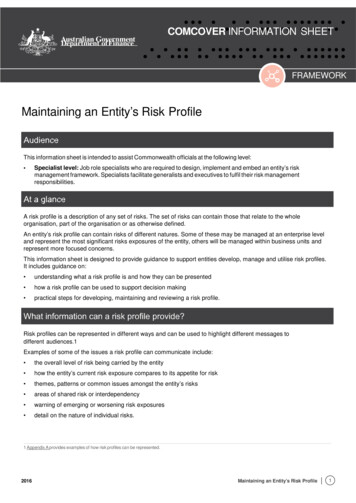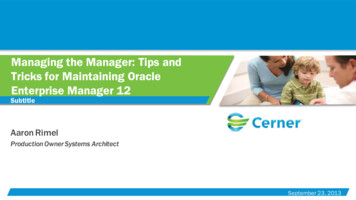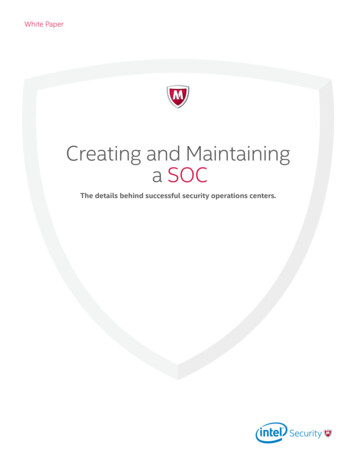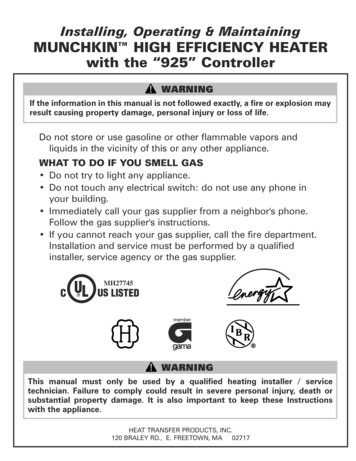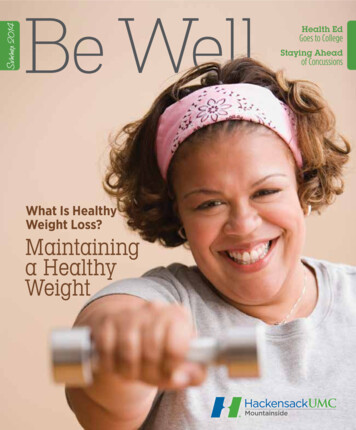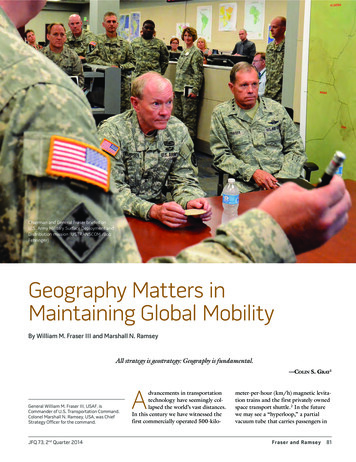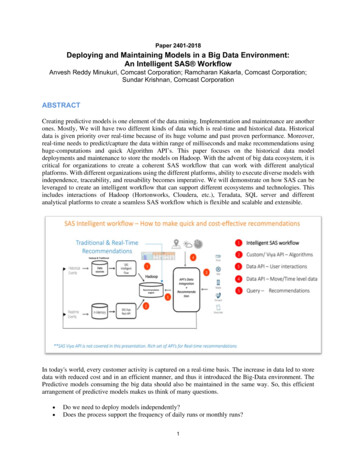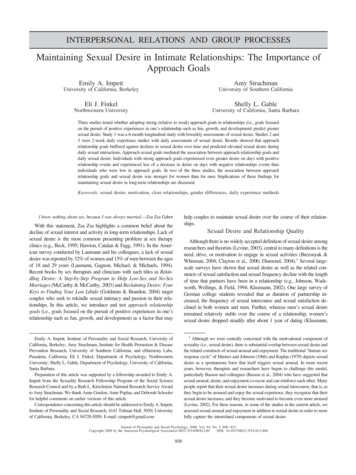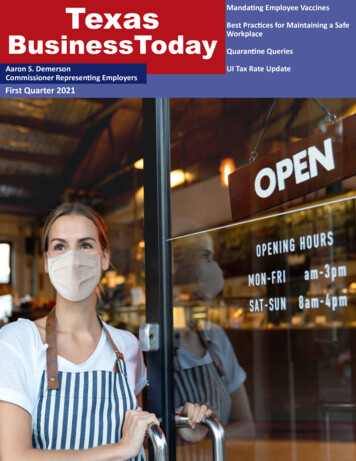
Transcription
TexasBusinessTodayAaron S. DemersonCommissioner Representing EmployersFirst Quarter 2021Mandating Employee VaccinesBest Practices for Maintaining a SafeWorkplaceQuarantine QueriesUI Tax Rate Update
Commissioner’s CornerTexas Continues to Lead theWay in 2021Dear Texas Employers,Welcome to our 2021 firstquarter issue of Texas BusinessToday! This newsletter is designedto address topics, as well asnew issues, that are emerging inemployment law. Our office createsthese articles based on the mostfrequently asked questions wereceive. We know it is importantto keep you up-to-date on allinformation that is beneficial toyou and your business.In most recent news, on March2nd, Governor Abbott issued a newExecutive Order, which includedopening Texas businesses 100%.My office will be hosting a townhall to discuss this new Orderand what it means for our Texasemployers on March 10th from11:30am-12:45pm. To register,click HERE.Equally as important, thepandemic, and the unusual weekof weather in Texas, has been frontand center for Texas Employers.The historic number of claims ourTexas Workforce Commission(TWC) staff handled this pastyear has been staggering. SinceMarch of 2020, more than 7million claims have been filed forunemployment and more than 42billion has been paid out to Texans.2To put this in better perspective,TWC took about 1 years’ worth ofclaims in a one-month timeframe.We addressed this monumentaltask by immediately taking actionand called for an all hands-ondeck approach. This includedincreasing the number of callcenters available and extendingthe hours and days open, to ensureno Texan would be left behind.The team in my officeproactively held over 60virtual town hall meetings withvarious Chamber of Commerceorganizations, elected officials,and industry associations toassist our Texas employers withrelevant answers to their pressingquestions. We also handledthousands of calls and emailsand continue to do so. Our TexasEmployer Hotline (1-800-8329394) is available to all Texasemployers. Or if they prefer,Texas employers can email ouroffice at: employerinfo@twc.state.tx.us.In addition, we createdLunchtime Live!, a 90-minutevirtual employment law sessionfeaturing our employment lawattorneys. These events, whichserved as a temporary replacementfor our standard Texas Conferencefor Employers, drew over 6000Texas employers and coveredmany topics.Even through theseunprecedented times, Texascontinued to lead the way andremain at the top of many lists. Forthe 16th year in a row, Texas wasvoted by CEOs across the nationas the best state for business.Also, for a record-shattering 9thyear in a row, Texas was awardedthe Site Selection Governor’sCup for job performance andcapital investment, and the listgoes on. The Governor has issuedhis priorities for the session andthe interest of Texas Employersremains at the top of his list.Regarding the 2021Unemployment Tax Rate, pleasesee the article on page 12 for thelatest information. Our goal is toensure we keep the UI tax ratesas low as possible for our Texasemployers.As the 87th Texas Legislaturehas begun, we will follow allbills related to employment lawand continue to provide updatesthroughout the session.As we continue through the year,our office remains committed toensuring you have the best andmost updated information to assistyou with successfully operatingyour business. Thank you for ALLyou do. Let’s Continue to MakeProgress!Sincerely,Aaron S. DemersonTexas Workforce CommissionCommissioner Representing EmployersTexas Business Today First Quarter 2021
Texas Conference for EmployersPlease join us for an informative, full-dayor two-day conference where you will learnabout relevant state and federal employment laws that are essential to efficientlymanaging your business and employees.2021 Conference LocationsLive conferences may resume in thesummer of 2021. We will continueto monitor the matter of in-personmeetings and will confirm throughour website and mailed invitationsper location.We have assembled our best speakers toguide you through ongoing matters of concern to Texas employers and to answer anyquestions you have regarding your business.Topics include matters such as:Hiring Issues · Employment Law Updates· Personnel Policies and Handbooks ·Workers’ Compensation · IndependentContractors and Unemployment TaxIssues · The Unemployment Claims andAppeals Process · Texas and FederalWage and Hour LawsThe non-refundable registration fee is 175 (one day) and 225 (two days). The Texas WorkforceCommission and Texas SHRM State Council are now offering SHRM and Human Resources Certification Institute (HRCI) recertification credits targeted specifically for Human Resource professionalsattending this conference. For more information on how to apply for these Professional DevelopmentCredits upon attending the Texas Conference for Employers, please visit the Texas SHRM website.Also, attorneys may receive up to 5.5 hours of MCLE credit (no ethics hours) if they attend the entirefull-day conference, or 11 hours for the two-day conference (one hour of ethics available). ContinuingEducation Credit (six hours) is available for CPAs. General Professional Credit is also available.CONTENTS247101213Commissioner’s CornerQuarantine QueriesMandating EmployeeVaccinesUnemployment TaxRates for 2021Texas Business Today First Quarter 2021Best Practices forMaintaining Safe WorkplaceNew and Extended Unemployment Insurance Programs3
Mandating Employee VaccinesBy Velissa Chapa/ Legal Counsel to Commissioner Aaron S. DemersonEmployees may refuse a vaccine due to sincerely held religious beliefs, or for legitimate medical reasons,such as pregnancy, severe adverse effects, or a life-threatening allergy to the vaccine.Mandating vaccines is tricky business, even duringa pandemic. There are various legal issues employersshould be aware of before moving forward with anykind of mandatory vaccination policy. In fact, it isbecause of these issues that many employers chooseto encourage employee vaccinations instead ofmandating them.Before COVID-19, various federal agenciesprovided guidance on mandating other types ofvaccinations (such as the flu shot). There is a beliefthat this guidance has shifted significantly in lightof the recent pandemic. However, a pandemic doesnot nullify certain legal protections for employees.The following is an explanation of what those legalprotections are, what employers must do to balancethem, and best practices.Protected Reasons for Refusal:Medical and ReligiousSome reasons for refusing a vaccine are protectedunder federal law. Title VII of the Civil Rights Actof 1964 (Title VII)—which applies to employerswith 15 or more employees—prohibits employmentdiscrimination based on religion or a medical contraindication.Employees may refuse a vaccine due to sincerely held religious beliefs, or for legitimate medical4reasons, such as pregnancy, severe adverse effects, ora life-threatening allergy to the vaccine. Whether thereason for refusal is religious or medical in nature,the result is the same: the employer would need totake steps to reasonably accommodate that employee,unless doing so would pose an undue hardship. Reasonable accommodation could mean exempting thatemployee from the vaccination requirement.Employers may believe that reasonable accommodation is not possible during a time of a pandemic.They should keep in mind that the Centers for Disease Control (CDC) and the Occupational Safety andHealth Administration (OSHA) have provided guidance on infection-control practices, such as socialdistancing, the use of PPE such as gloves, masks,and face shields, and sanitization of the workplace.Continued use of these practices could constitute reasonable forms of accommodation, arguably makingit more difficult to prove undue hardship. Of course,each case must be addressed on a case-by-case basis.For more information, see questions K.6 and K.7 inthe following guidance from the Equal EmploymentOpportunity Commission (EEOC): o-laws.Therefore, employers who choose to mandate vaccines for employees would do well to have a writtenpolicy, and the policy should provide for religiousTexas Business Today First Quarter 2021
and medical exemptions, as well as include a procedure for how such issues should be addressed.For further guidance on appropriate medical inquiries, whether the employee’s lack of vaccinationwould pose a “direct threat” to the workplace, reasonable accommodation, undue hardship, and practices for preparedness, see the EEOC’s guidance onpandemic preparedness: andemic flu.pdf (see page 10for information on mandating vaccines).Unprotected Reasons for RefusalAn employee may refuse a vaccine for moral,social, or political reasons, or as a matter of personalpreference. However, according to the EEOC, noneof these arguments constitute legally-protected reasons for refusing a vaccine.Additional Legal ConcernsBusinesses with less than 15 employees are notcovered under Title VII, but the guidance for employers in this category remains the same, just for different, additional reasons.First, employers should remember that employeeswho are injured from taking a mandatory vaccinecould have a Workers’ Compensation claim againstthe employer. For employers who do not have Work-ers’ Compensation, legal liability could still resultfrom employee harm.In addition, mandatory vaccines could lead to employee discussions about the policy. Such discussionsmay be protected under the National Labor RelationsAct (NLRA). Under this federal law, employees havethe right to discuss their working conditions with oneanother, and disciplining or preventing employeesfrom having such discussions could result in a violation of the NLRA: -8a1.Employees who are terminated for refusing toreceive the vaccine may file for unemployment benefits. Depending on the facts of the case, an employeemay be eligible to receive unemployment benefits,and the employer could be charged.Finally, all employers—regardless of size—thatmandate vaccines and do not pay for the associatedcosts may risk a racial discrimination lawsuit under42 U.S.C. §1981, as such a practice may have a disparate impact on minority populations: 981.pdf. Employers should also pay for the vaccine ifthere is a risk that not doing so would take the employee below minimum wage.Mandatory vaccines could lead to employee discussions about the policy. Such discussions may be protectedunder the National Labor Relations Act (NLRA).Texas Business Today First Quarter 20215
In general, mandatory vaccination requirements are not recommended for employers outside of the healthcareindustry, due to the complicated issues that can arise from such a mandate.Employers in the HealthcareIndustryMany employers in healthcare believe that thereis a special exception that applies to employers inthe healthcare industry. The belief is that mandatingvaccines without exception is crucial because of theheightened responsibility of maintaining the healthand well-being of patients. However, there is no specific exception for the healthcare industry, and healthcare employers fall under the same analysis as above.As an example, the case of EEOC v. Saint VincentHealth Care Center, Civil Action No. 1:16-cv-234(Sept. 22, 2016), the employer paid 300,000 in backpay and compensatory damages to six employeeswhose religious exemption requests were denied. Theprimary lessons from this case include that:1. Employers must notify employees of their rightto request an exemption and establish appropriateprocedures;2. Employers cannot reject a religious accommodation simply because they do not agree with thereligion; and3. Employers cannot require exemption requests tobe certified by clergy members (see tion-lawsuit).Being in the healthcare industry does not, by itself,relieve employers from the obligations to reasonablyaccommodate employees under Title VII, nor does itcompletely shield the employer from the other legalconcerns listed.6Best PracticesIn general, mandatory vaccination requirementsare not recommended for employers outside of thehealthcare industry due to the complicated issues thatcan arise from such a mandate. For those employerswho do choose to mandate employee vaccines, theyshould make the exemptions for medical or religiousreasons clear in policy, create a process for optingout, and consider only applying the policy towardsemployees who regularly interact with patients. Donot forget to train managers on how to handle refusals and accommodation requests, and remind employees of OSHA and CDC guidelines and make resources easily accessible to employees (the Department ofLabor has compiled a list of COVID-19 resources foremployers: us).Employers may also need to pay for the vaccineand reasonably accommodate if an exemption isrequested. Consider providing paid time-off foremployees who elect to take the vaccine. Do notretaliate, and remember: each case stands alone, sokeep excellent documentation of the accommodationprocess. Finally, employers should continue to implement mandatory infection-control practices, such associal distancing, sanitizing, and the use of PPE.ConclusionAlthough it is not generally recommended thatemployers mandate employee vaccinations, employers can certainly encourage employees to do so. Ofcourse, employers who are interested in imposinga mandatory vaccination requirement should seek aqualified attorney of their choosing to assist in thedevelopment and enforcement of such a mandate.Texas Business Today First Quarter 2021
Best Practices for Maintaining a Safe WorkplaceBy Mario Hernandez / Legal Counsel to Commissioner Aaron S. DemersonIt is now more important than ever for employers to know about some of the best practices for maintaining asafe workplace in the time of the coronavirus.Employers have traditionally been aware of theirresponsibility to maintain a safe workplace. Whileundoubtedly the main basis for such efforts has beento ensure the well-being and best interests of theiremployees, employers have also implemented safetymeasures to limit liability associated with workplaceaccidents and to avoid penalties from local, state, andfederal regulators. With COVID-19 infiltrating virtually all aspects of our lives, including the workplace,it is now more important than ever for employers toknow about some of the best practices for maintaining a safe workplace in the time of the coronavirus.Knowing Your ResourcesAs mentioned, employers implement safety measures at the workplace for a variety of reasons. Ata fundamental level, each safety measure that isimplemented starts with a plan. With that in mind,a good plan draws from reliable and knowledgeableresources. As far as COVID-19 safety protocols areconcerned, three of the biggest resources that Texasemployers should know about are the Centers for Disease Control and Prevention (CDC), the OccupationalSafety and Health Administration (OSHA), and theTexas Department of State Health Services (DSHS).Centers for Disease Control andPrevention (CDC)The CDC has plenty of guidance for employerswanting to maintain a safe workplace. The CDCrecommends that employers “implement and updateas neccesary a plan that: is specific to your workplace, identifies all areas and job tasks with potentialexposures to SARS-CoV-2 [the virus that causesCOVID-19], and includes control measures to eliminate or reduce such exposures.”Moreover, the CDC recommends that employers take action at limiting the spread of the virus byengaging in activities to “prevent and reduce transmission among employees, maintain healthy businessoperations, and maintain a healthy work environment.” More details about these activities can befound below.Prevent and Reduce Transmission AmongEmployeesThe CDC has guidance for employers seeking toprevent and reduce transmission among employees. This guidance includes actively encouragingsick employees to stay home, identifying where andhow workers might be exposed to individuals withCOVID-19 at work, taking action if an employee isTexas Business Today First Quarter 20217
suspected or confirmed to have COVID-19, and educating employees about steps they can take to protectthemselves at work and at home.Maintain Healthy Business OperationsThe CDC also has guidance for employers seeking to maintain healthy business operations. CDC’sguidance on this topic includes implementing flexiblesick leave and supportive policies and practices, communicating supportive workplace policies clearly,frequently, and via multiple methods, and establishing policies and practices for social distancing.Maintain a Healthy Work EnvironmentAnother big component of the CDC’s guidanceis to maintain a healthy work environment. Someof the CDC’s guidance on this topic includes givingemployees, customers, and visitors what they need toclean their hands and cover their coughs and sneezes,performing routine cleaning and disinfection, andminimizing risks to employees when planning meetings and gatherings.The information in this portion of the article relating to CDC guidance and more details can be foundat the following link: y/guidance-business-response.html.Occupational Safety and HealthAdministration (OSHA)OSHA also offers resource materials for employers wishing to maintain a safe workplace. OSHAhas resource information for best practices includingguidance for specific industries, information on hazard recognition, and guidance for returning to work.In addition, OSHA has helpful FAQs, PDF downloads, and information about workers’ rights and employer responsibilities. You can find this informationand more by visiting the following website: https://www.osha.gov/coronavirus.Texas Department of State HealthServices (DSHS)DSHS is another source of good information foremployers desiring to maintain a safe workplace.DSHS offers a wide array of resource material foremployers including communication tools, instructional videos, and information on minimum standardhealth protocols. For this information and more,please visit hen implementing a plan to maintain a safe workplace, employers should draw from relevant, knowledgeable,and accurate resources.8Texas Business Today First Quarter 2021
In addition to those mentioned above, here aresome other resources to assist employers in maintaining a safe workplace.Office of the Texas GovernorThe Office of the Texas Governor has useful information for employers, including COVID-19 resources. This information and more can be found at thefollowing link: https://gov.texas.gov/.Additionally, information on the Governor’s StrikeForce to Open Texas can be found at the followinglink: https://open.texas.gov/. Per that website: “TheGovernor’s Strike Force to Open Texas will safelyand strategically restart and revitalize all aspects ofthe Lone Star State—work, school, entertainment,and culture.” Information on the website also includes “Open Texas Checklists,” which describeminimum standard health protocols for all employersand event organizers, and other specific industries.For this information and more, please visit https://open.texas.gov/.Occupational Safety and Health ConsultationProgram (OSHCON)OSHCON also has resources for maintaining asafe workplace for employers. Per the OSHCONwebsite: “The Occupational Safety and Health Consultation (OSHCON) program (www.txoshcon.com)is a free and confidential service available to privateTexas employers through the Texas Department ofInsurance, Division of Workers’ Compensation. Ourprofessional safety and health consultants across thestate are available to help you identify and eliminateoccupational hazards in your workplace, whether ornot your company carries workers’ compensationinsurance.” You can find this information and more atthe OSHCON website at the following link: https://www.tdi.texas.gov/oshcon/index.html.Local GuidanceDepending on location, local authorities may havedifferent rules and regulations for that particular location. County and city officials are good sources ofinformation on rules and regulations for their respective jurisdictions.ConclusionMaintaining a safe workplace is a necessity for employers. It should also be noted that theabove-mentioned resources are not exhaustive andthere are surely other resources available to employers when crafting a plan to maintain a safe workplace. When implementing a plan to maintain a safeworkplace, employers should draw from relevant,knowledgeable, and accurate resources. Doing so willaid employers in establishing safe working environments for both their companies and their employees.ARE YOU AN EMPLOYER?IS YOUR WORKFORCEWECOMPOSED OFHIRE10% MILITARY VETERANS?VETSWE WANT TO RECOGNIZEFOR MOREYOU FOR OURINFORMATIONWE HIRE VETS PROGRAMGO TO: WWW.TEXASOPERATIONWELCOMEHOME.COMTexas Business Today First Quarter 20219
Quarantine Queries: Employer-MandatedQuarantine for Employee Travel or Off-DutyBehaviorBy Elsa Ramos/ Legal Counsel to Commissioner Aaron S. DemersonQ:A:Q:A:Q:A:Can an employer require employees to disclose past orfuture travel plans?There is currently no law that prohibits employers from requiring employees to disclosetravel plans. The employer may choose to inquire about all travel out of town, or limitthe inquiry to travel outside a large radius, for example, asking employees to inform theemployer if they plan to travel out of the state or the country. The employer will want anyinquiry to be job-related and consistent with business necessity.Can an employer require employees to self-quarantine (notcome into the office or worksite) if they have traveled out oftown/city/state/country or have engaged in risky behavior ontheir own time, such as attending large gatherings or parties?No law prohibits employers from requiring employees who have engaged is such activities to stay away from the office or worksite for a certain period of time. Since the purposeof this precaution is to minimize employee exposure to Covid-19, the length of the stayaway period should comply with guidance from the Centers for Disease Control (CDC)or other reliable authority. CDC recommendations regarding travel: s/index.htmlPlease note, if employees being asked to self-quarantine can work remotely during thequarantine period, employers are encouraged to keep employees working.If employees are not able to work remotely duringthe quarantine period, does the employer have to payemployees for that time?The answer depends on the type of employees at issue. For hourly employees, employersare required to pay for all hours worked. If an hourly employee is not working remotelywhile away from work, then the employer is not required to pay for the time off.For salaried exempt employees, employers are required to pay the full salary if the employee works part of any week. If a salaried exempt employee does not work a full week,the employer is not required to pay for the full week not worked. See: https://twc.texas.gov/news/efte/legal issues for military leave.html#salarydeductionsFor all employees, employers can look to their policies to see if there is some form ofpaid-time-off available, such as vacation hours, to cover some or all of the employees’leave.10Texas Business Today First Quarter 2021
Q:A:Q:A:Q:A:Can an employee who is neither working nor getting paidduring the self-quarantine file an unemployment claim forthat period?Yes. If an employee is no longer performing services for pay, the employee can file anunemployment claim.Can an employer require employees who were on employermandated quarantine to submit a negative Covid-19 testbefore returning to work?There is no law that prohibits this request. However, since this type of self-quarantine isrequested by the employer, without manifestation of any symptoms or illness, employersshould consider how useful it is to request a negative Covid-19 test. In addition, someauthorities, such as the CDC, recommend that employers not require sick employees toprovide a Covid-19 test result or medical note due to various reasons. See: y/general-business-faq.htmlIf the employer requires employees in employer-mandatedquarantine to take a Covid-19 test before returning to work,does the employer have to pay for the test?If the employer requires an employee who is not ill and who has no symptoms to providea negative Covid-19 test before returning to work, the employer is responsible for payingfor the employer-mandated test.The employer may choose to inquire about all travel out of town, or limit the inquiry to travel outside a largeradius, for example, asking employees to inform the employer if they plan to travel out of the state or the country.Texas Business Today First Quarter 202111
Unemployment Tax Rates for 2021By Tommy Simmons/ Senior Legal Counsel to Commissioner Aaron S. DemersonAn important component is the benefit ratio, which isthe three-year chargeback total divided by the threeyear taxable wage total.Late last year, the Texas Workforce Commissionannounced that employers’ state unemployment insurance (UI) tax rates for 2021 would be published andmailed to employers later than the usual target dateof the second week of December. That was primarily due to TWC wanting to consider all possibilities,including adjustments of certain tax rate components,legislative action, potential federal funds, and extensions of deadlines, in an effort to keep UI tax rates aslow as possible.The rates will be set as soon as possible (at the latestby the end of June, 2021), but for purposes of settingup payroll systems and budgeting, employers maywant to choose from the current published 2020 rateswhich are: minimum tax rate .31%; average tax rate 1.14%; maximum tax rate 6.31% and the entrylevel tax rate for new employers 2.7% and makeadjustments once the actual 2021 rates are published.New employers pay at 2.70% for the first six calendar quarters of operation and are eligible for anexperience rating subsequently and thereafter basedon their companies’ individual history of employmentseparations. Employers with no chargebacks duringthe past three years may receive the minimum taxrate. Employers with chargebacks during the pastthree years will have a calculated tax rate above theminimum.12The following is a breakdown of the General TaxRate, which is the central component: Benefit Ratio: Unique to each employer account. Itis the three-year history of total chargebacks dividedby three-year history of total taxable wages. Replenishment Ratio: Computed according to statelaw is one of the primary mechanisms for dealingwith half of the shortfall in the UI Trust Fund. Thisratio is the same for each employer account. General Tax Rate: Benefit Ratio x ReplenishmentRatioIt is important for employers to respond to anynotice of Maximum Potential Chargeback as soon aspossible. Any increases to the total amount of chargebacks used in the Benefit Ratio may result in a higherGeneral Tax Rate component.Once the General Tax Rate is computed, it canstatutorily increase to a maximum of 6.00%. Otherrate components are then added to produce a totalAnnual Effective Tax Rate: Replenishment Tax Rate: The other mechanism fordealing with half of the shortfall in UI Trust FundThis rate is the same for each employer account. Interest Tax: Used if Texas owes interest on a federalUI loan. Obligation Assessment Tax: Established if Texas needs to repay bonds issued to repay federal UIloans. Deficit Tax: Created according to state law if there isa deficit in the floor of the UI Trust Fund.Individual tax rate calculations can become quitecomplex based on individual company circumstances. A detailed illustration of the formula appears surance-tax-rates.The latest news on UI tax rates is online at p-month#january01 and updates will also be posted periodically on this same link.Texas Business Today First Quarter 2021
New and Extended UnemploymentInsurance ProgramsBy Tommy Simmons/ Senior Legal Counsel to Commissioner Aaron S. DemersonThe federal government extended the CARES Actlegislation of March 27, 2020 by enacting the Continued Assistance Act (CAA) on December 27, 2020.The CAA provides extensions of existing federalbenefits and creates new categories of benefits, asoutlined below.Pandemic Emergency Unemployment Compensation (PEUC) benefits have been extended for 11weeks, beginning with the week ending January 2,2021 and ending with the week ending March 13,2021. If a claimant has not yet drawn the 11 additional weeks of PEUC benefits by that time, they cancontinue receiving such benefits through a phase-outperiod that ends on April 10, 2021. The amount of theweekly PEUC benefit will the same as the previousPEUC benefit.Pandemic Unemployment Assistance (PUA)benefits have also been extended by the CAA for anadditional 11 weeks, with the same beginning, ending,and phase-out period dates noted above for PEUCbenefits. The amount of the PUA benefit during theextension period will be the same at it was in 2020.Additionally, Federal Pandemic UnemploymentCompensation (FPUC) benefits, which originallyexpired in Texas on July 25, 2020, have been renewedfor the same beginning and ending dates that apply tothe additional PEUC and PUA
the 16th year in a row, Texas was voted by CEOs across the nation as the best state for business. Also, for a record-shattering 9th year in a row, Texas was awarded the Site Selection Governor’s Cup for job performance and capital investment, and the list goes on. The Governor has issu




